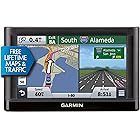The hum of the engine, the rumble of the tires on gravel – these are the sounds of rural life, often accompanied by the quiet confidence of knowing your way around. But for decades, navigating the intricate web of backroads and unmarked trails presented a significant challenge. The introduction of GPS navigators has profoundly impacted rural accessibility, offering both immense benefits and unexpected complexities. This article delves into how GPS technology has reshaped the rural landscape, exploring its impact on everything from emergency services to tourism, while also acknowledging the limitations and potential pitfalls.
Enhanced Emergency Response Times

One of the most significant impacts of GPS navigators has been on emergency response times. Previously, reaching remote locations in rural areas often involved painstakingly following paper maps, relying on local knowledge, or even resorting to guesswork. This often resulted in precious time lost, leading to potentially life-threatening delays in medical emergencies, fire responses, and police interventions. GPS technology, however, has revolutionized this. Ambulances, fire trucks, and police vehicles can now receive precise location data, allowing them to navigate directly to the scene of an incident, even in the most remote locations. This has resulted in significantly improved response times, leading to better outcomes and saving lives.
Improved Accessibility for Healthcare and Essential Services
Access to healthcare and essential services is often a significant challenge in rural areas. Long distances, poor road conditions, and lack of familiar routes can make it difficult for residents to reach hospitals, pharmacies, and other vital facilities. GPS navigators have mitigated this problem considerably. Individuals can now easily find the nearest healthcare provider, plan their journey in advance, and even share their location with family or emergency contacts. This enhanced accessibility has significantly improved healthcare outcomes and quality of life for those living in rural communities.
Boosting Rural Tourism and Economic Development

Tourism is increasingly vital for the economic well-being of many rural areas. GPS navigators have played a critical role in this growth by providing tourists with easier access to remote attractions and hidden gems. Previously, exploring the countryside might have involved relying on outdated maps and potentially getting lost. Now, tourists can confidently explore less-traveled routes, discovering breathtaking landscapes and local businesses that were previously inaccessible. This increased tourism translates to economic opportunities for local businesses, from bed and breakfasts to restaurants and adventure tour operators. The ease of navigation provided by GPS has unlocked the potential of rural tourism, bringing both economic prosperity and a wider appreciation of these unique areas.
Challenges and Limitations of GPS in Rural Settings
While the benefits are numerous, it’s crucial to acknowledge the limitations of GPS technology in rural environments. Signal strength can be unreliable in remote areas with dense tree cover or mountainous terrain. GPS signals can be weak or nonexistent in some deep valleys or canyons, causing navigation difficulties. Furthermore, reliance on GPS can sometimes lead to a decreased understanding of the local area and a dependence on technology rather than developing navigational skills. This is a concern particularly for emergency responders and those who might need to navigate without electronic assistance.
Addressing the Challenges: Offline Maps and Hybrid Approaches

To overcome the limitations of GPS, a hybrid approach often proves most effective. Carrying paper maps alongside a GPS navigator allows for backup in case of signal loss. Many navigation apps now offer downloadable offline maps, providing navigation capabilities even without a cellular or satellite signal. Promoting the responsible use of GPS, encouraging navigation skills training, and investing in infrastructure improvements to enhance signal strength are all crucial steps in maximizing the benefits of this technology while minimizing its drawbacks.
The Future of GPS and Rural Accessibility
The future of GPS navigation in rural areas is bright, with continuous technological advancements promising even greater improvements. Improved satellite constellations, more accurate mapping techniques, and the integration of other technologies like augmented reality are expected to further enhance navigation capabilities in challenging environments. Furthermore, the growing use of connected vehicles and smart infrastructure will improve communication between vehicles and the surrounding infrastructure, helping drivers navigate more easily and safely, particularly in rural areas with less developed infrastructure. The ongoing development and integration of these technologies promise to continually enhance the positive impact of GPS on rural accessibility and quality of life.
Conclusion: Embracing the Potential

The impact of GPS navigators on rural accessibility has been transformative. While challenges remain, the overall benefits far outweigh the limitations. By embracing a multi-faceted approach, combining the convenience of GPS technology with traditional navigation skills and preparing for potential signal loss, we can fully harness the power of GPS to enhance safety, improve access to essential services, and foster economic growth in rural communities worldwide. The future undoubtedly holds further advancements that will continue to shape the relationship between technology and rural life, promising even greater connectivity and opportunity.